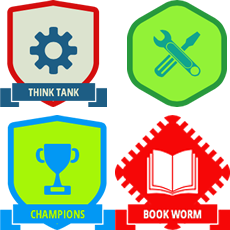As schools progress to include online and on-campus courses and activities, digital badges are suited to meet the needs of emerging education models
 As children, our accomplishments were recognized with trophies, plaques, a pat on the back or cloth badges sewn on to a Girl Scout or Boy Scout sash.
As children, our accomplishments were recognized with trophies, plaques, a pat on the back or cloth badges sewn on to a Girl Scout or Boy Scout sash.
In high school and college, we received diplomas and began to fill up resumes and LinkedIn profiles with job qualifications and experience. But what if there was a way to help acknowledge educational experiences that happen outside of the classroom and recognize valuable skills such as leadership or collaboration?
To address this need, the trend of digital badges is rapidly catching on. But what will be its impact and potential on education?
(Next page: Examining Digital Badge effectiveness)
Digital badges have many applications, but most importantly, they associate people with the knowledge and skills they possess – the short definition is “a validated indicator of accomplishment.” In today’s always-on environment, smart phone apps such as Foursquare incorporate the concept of badges to encourage game competition and offer rewards. In the academic domain, the concept of awarding badges is taken straight from the realm of gaming into the professional world.
In its truest form, a digital badge is simply a graphic accompanied by a description awarded to someone who has demonstrated specific skills or knowledge. Much like cash, digital badges are portable and verifiable. By being instantly verifiable, digital badges have an advantage over college degrees, resumes and transcripts.
What is a Digital Badge?
Watch this brief video clip on digital badges.
Digital technology is fast-paced and is already starting to replace the standard way of doing things, such as the process of tracking down and contacting the university issuing a diploma. In education, badges represent an accurate depiction of what a student actually knows rather than what their standardized-test score or report card says about them.
The concept of digital badges was boosted in 2012 when Mozilla Open Badges developed an open system for representing and displaying badges. From that point, the early and most active uses of digital badges have been with online courses. One step toward becoming mainstream that is already underway is their incorporation into learning management systems (LMS) like Blackboard Learn and Moodle.
How Are They Effective?
There are two main benefits to the concept of digital badges: motivation and certification.
Motivation comes from the use of gamification, the concept of applying game-design thinking to non-game applications to make them more fun and engaging. Gamification has been a popular new trend, especially in the corporate world to help increase employee engagement, and the use of games at work or at school has definitely resonated with millennials. The certification aspect of digital badges provides widely-accepted recognition to an individual’s development.
Education has been a leading adopter of digital badges to enhance student development and recognize learning. The classroom has evolved and by integrating digital technology, now provides a blended learning environment with increasing use of collaboration tools.
This new hybrid connected classroom has created a new model for educating students, but presents a challenge for motivating and recognizing student achievement. By developing innovative uses of digital badging, companies such as Blackboard and Pearson, along with universities such as Purdue and Quinnipiac, have overcome this challenge.
For example, last year Blackboard announced a partnership with Mozilla to support the use of digital badges to promote achievements in courses and within Blackboard Learn™. By utilizing Mozilla’s Open Badges Infrastructure, students can earn Open Badges to indicate the completion of a course or meeting learning milestones set by faculty. Within a course, students can also view and share earned badges and see how much progress they have made toward requirements for earning new ones.
The program provides incentives for students to learn and further engage both inside and outside of the classroom. Their initiative goes far beyond the traditional achievement process by assigning awards for extracurricular activities, philanthropy, study abroad and internships. In addition, students can display their badges in an Open Badge portfolio as well on networking profiles, social media sites and personal web pages.
What is the Potential of Digital Badges?
It is clear that digital badges have the potential to replace or enhance outdated, traditional ways of measuring and communicating students’ skills and knowledge. For example, resumes are often more about writing skills than professional abilities, interviews are an important skill but aren’t related to your job, pre-employment tests may not accurately reflect skills due to nervousness, and personal recommendations may reflect the selling skills of the recommender rather than the skills of the candidate.
In order to become mainstream in education, digital badges must first establish credibility and overcome the perception that they are only used for gaming and marketing. Over time, digital badges could replace certificates and diplomas. As schools progress to include a mix of online and on-campus courses and activities, digital badge systems are well-suited to evolve to meet the needs of emerging education models.
Robert Nilsson is Director of Vertical Solutions at Extreme Networks.
- Three Ways Digital Badges are Used in Education - May 30, 2014
